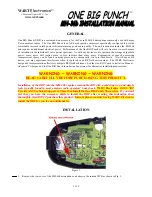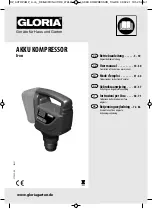
Portable Compressor 7/20
5---2
SEPTEMBER 2003
(2.) The use of the compressor after such a device or an
element of design has been removed or rendered
inoperative by any person.
5.2.1.
Noise Emission Warranty
The manufacturer warrants to the ultimate purchaser and each
subsequent purchaser that this air compressor was designed,
built and equipped to conform at the time of sale to the first retail
purchaser, with all applicable U.S. EPA Noise Control
Regulations.
This warranty is not limited to any particular part, component, or
system of the air compressor. Defects in the design, assembly,
or in any part, component, or system of the compressor which,
at the time of sale to the first retail purchaser, caused noise
emissions to exceed Federal Standards are covered by this
warranty for the life of the air compressor. (40FR204.58---1).
5.2.2.
Introduction
The unit for which this Maintenance Log is provided conforms
to U.S. EPA Regulations for Noise Emissions, applicable to
Portable Air Compressors.
The purpose of this book is to provide:
(1.) The Maintenance Performance Schedule below for all
required noise emission controls,
(2.) Space so that the purchaser or owner can record what
maintenance was done, by whom, where
and when.
Detailed instructions on the maintenace item bellow are given
on the following page.
5.3.
MAINTENANCE PERIOD
Table 5-- 1.
MAINTENANCE PERIOD
ITEM
AREA
PERIOD
A.
COMPRESSED AIR LEAKS
AS DETECTED
B.
SAFETY AND CONTROL SYSTEM
AS DETECTED
C.
ACOUSTIC MATERIALS
DAILY
D.
FASTENERS
100 HOURS
E.
ENCLOSURE PANELS
100 HOURS
F.
AIR INTAKE & ENGINE EXHAUST
100 HOURS
G.
COOLING SYSTEMS
250 HOURS
H.
ISOLATION MOUNTS
250 HOURS
I.
ENGINE OPERATION
SEE
9. MAINTENANCE
SECTION OF THIS MANUAL
J.
FUELS & LUBRICANT
SEE
9. MAINTENANCE
SECTION OF THIS MANUAL
A. COMPRESSED AIR LEAKS
Correct all compressed air leaks during the first shutdown
period after discovery. If severe enough to cause serious
noise problems and efficiency loss, shutdown immediately
and correct the leak(s).
B. SAFETY AND CONTROL SYSTEMS
Repair or replace all safety and control systems or circuits
as malfunction occurs. No compressor should be operated
with either system bypassed, disabled, or nonfunctional.
C. ACOUSTIC MATERIALS
In daily inspections, observe these materials. Maintain all
acoustic material as soon as possible in its original
condition. Repair or replace all sections that have
sustained damage, have partially separated from the
panels to which they were attached, are missing, or have
otherwise deteriorated due to severe operating or storage
conditions.
D. FASTENERS
All fasteners such as hinges, nuts, bolts, clamps, screws,
rivets and latches should be inspected for looseness after
each 100 hours of operation. They should be retightened,
repaired, or --- if missing --- replaced immediately to prevent
subsequent damage and noise emission increase.
E. ENCLOSURE PANELS
Enclosure panels should also be inspected at 100 hour
operational intervals. All panels that are warped,
punctured, torn, or otherwise deformed, such that their
noise containment function is reduced, should be repaired
or replaced before the next operation interval. Doors,
access panels, and hatch closures especially, should be
checked and adjusted at this time to insure continuous
sealing between a gasket or acoustic material and the
mating frame.
F.
AIR INTAKE AND ENGINE EXHAUST
Engine and compressor air intake and engine exhaust
systems should be inspected after each 100 hours of
operation
for
loose,
damaged,
or
deteriorated
components. Repairs or replacements should be made
before the next period of use.
G. COOLING SYSTEMS
All components of the cooling systems for engine water
and compressor oil should be inspected every 250 hours
of use. Any discrepancies found should be corrected
before placing the unit back in operation. Unrestricted
airflow over the radiator and oil cooler must be maintained
at all times during operation.
















































